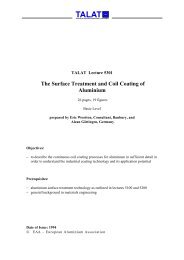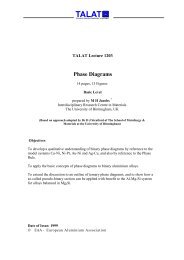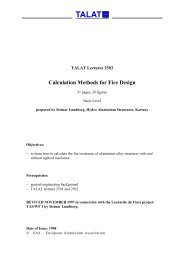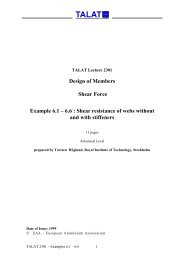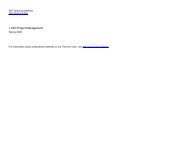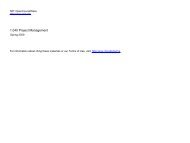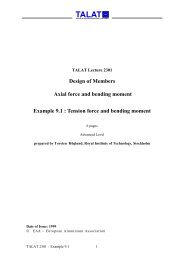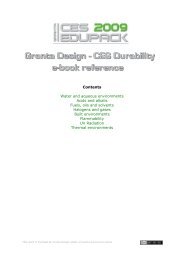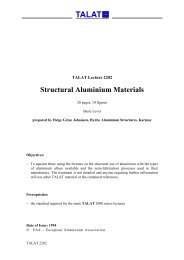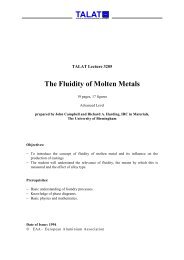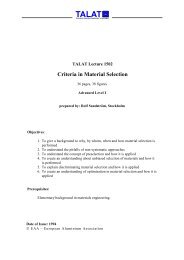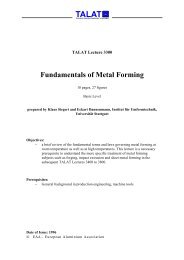Formability Characteristics of Aluminium Sheet - CORE-Materials
Formability Characteristics of Aluminium Sheet - CORE-Materials
Formability Characteristics of Aluminium Sheet - CORE-Materials
You also want an ePaper? Increase the reach of your titles
YUMPU automatically turns print PDFs into web optimized ePapers that Google loves.
Fields <strong>of</strong> Application <strong>of</strong> <strong>Aluminium</strong> Body <strong>Sheet</strong> Alloys<br />
Figure 3701.02.02 lists the most important European, American and Japanese body<br />
sheet alloys.<br />
The aluminium alloys are divided into a group <strong>of</strong> heat-treatable alloys (groups 3 - 5) and<br />
a group <strong>of</strong> non-heat-treatable alloys (group 2). The table lists the fields <strong>of</strong> application<br />
together with a reference to the presence and types <strong>of</strong> stretcher strains.<br />
Source: F. Ostermann<br />
alu<br />
Training in <strong>Aluminium</strong> Application Technologies<br />
DIN<br />
Designation<br />
Group 1: aluminium, unalloyed<br />
Al99,5 W7<br />
1050-0<br />
Group 2: AlMg(Mn,Cr), non-heat-treatable<br />
AlMg2,5 W18<br />
AlMg3 W19<br />
AlMg5Mn W27<br />
AlMg5Mn<br />
Group 3: AlMgSi(Cu,Mn), heat-treatable<br />
----------<br />
----------<br />
AlMg0,4Si1,2<br />
----------<br />
Group 4: AlCuMg(Si), heat-treatable<br />
----------<br />
----------<br />
----------<br />
----------<br />
Group 5: AlMgCu(Zn), heat-treatable (conditionally)<br />
----------<br />
----------<br />
International<br />
5052-0<br />
5754-0<br />
5182-0<br />
5152-ssf<br />
6009-T4<br />
6010-T4<br />
6016-T4<br />
6111-T4<br />
2002-T4<br />
2008-T4<br />
2036-T4<br />
2038-T4<br />
GZ45/30-30<br />
KS5030<br />
TALAT 3701 14<br />
Stretcher<br />
strains<br />
none<br />
(A),B<br />
A , B<br />
A , B<br />
B<br />
none<br />
none<br />
none<br />
none<br />
none<br />
none<br />
none<br />
none<br />
(B)<br />
(B)<br />
Fold<br />
type<br />
NF<br />
NF<br />
NF<br />
NF<br />
NF<br />
NF<br />
TF<br />
(NF)<br />
TF<br />
TF<br />
TF<br />
TF<br />
---<br />
NF<br />
NF<br />
Information in parenthesis ( ) based on assumptions<br />
A, B = Stretcher strain types; ssf = no stretcher strains (type A)<br />
NF = normal fold; TF = double fold<br />
Field <strong>of</strong> application<br />
(examples)<br />
heat reflectors<br />
internal body parts<br />
internal body parts<br />
internal body parts<br />
internal/ext. parts<br />
internal/ext. parts<br />
external body parts<br />
external body parts<br />
external body parts<br />
external body parts<br />
external body parts<br />
external body parts<br />
external body parts<br />
internal/ext. parts<br />
internal/ext. parts<br />
Fields <strong>of</strong> Application <strong>of</strong> <strong>Aluminium</strong> Body <strong>Sheet</strong> Alloys 3701.02.02<br />
Compositions and Properties <strong>of</strong> <strong>Aluminium</strong> Car Body <strong>Sheet</strong> Alloys<br />
The chemical composition and the mechanical and technological properties <strong>of</strong><br />
aluminium sheet alloys usually used in the automotive industry are tabulated in Figure<br />
3701.02.03 and Figure 3701.02.04.<br />
3701.03 Technological Testing Methods<br />
Whereas the tensile test and the measured tensile properties <strong>of</strong> sheet metals are<br />
significant for the characterisation <strong>of</strong> the material’s quality, there are no simple<br />
relationships between the tensile properties and the forming behavior in the press. The<br />
state <strong>of</strong> stress, the strain path history, the geometrical dimensions and the tribological



